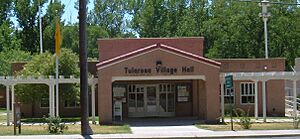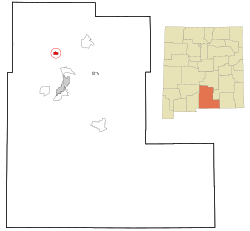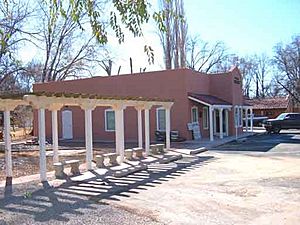Tularosa, New Mexico facts for kids
Quick facts for kids
Tularosa
|
|
|---|---|
|
Village
|
|

Tularosa Village Hall
|
|
| Motto(s):
"City of Roses"
|
|

Location of Tularosa, New Mexico
|
|
| Country | United States |
| State | New Mexico |
| County | Otero |
| Founded | 1863 |
| Area | |
| • Total | 2.82 sq mi (7.30 km2) |
| • Land | 2.82 sq mi (7.30 km2) |
| • Water | 0.00 sq mi (0.00 km2) |
| Elevation | 4,515 ft (1,376 m) |
| Population
(2020)
|
|
| • Total | 2,553 |
| • Estimate
(2022)
|
2,593 |
| • Density | 920.0/sq mi (355.1/km2) |
| Time zone | UTC–7 (Mountain (MST)) |
| • Summer (DST) | UTC–6 (MDT) |
| ZIP code |
88352
|
| Area code(s) | Area code 575 |
| FIPS code | 35-79980 |
| GNIS feature ID | 2413595 |
Tularosa is a small village located in Otero County, New Mexico, in the United States. It is named after the Tularosa Basin, a large desert area where the village sits. To the east, Tularosa is next to the Sacramento Mountains.
In 2020, about 2,553 people lived in Tularosa. The village is known for its many cottonwood trees. It also works hard to keep its old adobe-style buildings looking good. Many people who work in the larger city of Alamogordo live in Tularosa.
Contents
- What is the History of Tularosa?
- Where is Tularosa Located?
- What is the Population of Tularosa?
- What Festivals and Events Happen in Tularosa?
- What are the Main Points of Interest in Tularosa?
- How Do People Travel in Tularosa?
- What Schools are in Tularosa?
- Who are Some Famous People from Tularosa?
- What is the USS Tularosa?
- Images for kids
- See also
What is the History of Tularosa?
Tularosa gets its name from Spanish words that describe the red or rose-colored reeds. These reeds grew along the banks of the Rio Tularosa. This river, which is still on the north side of the village, was important. It attracted the first settlers because it was a source of water in the desert.
When Was Tularosa Founded?
People first tried to settle here in 1860. However, attacks from the Mescalero Apache people made it too difficult. Two years later, in 1862, Mexican farmers from the Rio Grande valley successfully settled the area. This happened after a battle at a place called Round Mountain.
In 1863, the village of Tularosa was officially created. A map was made with 49 blocks, and water rights were given to people. The Mission Church, called St Francis de Paula, was built. This church honored a promise made to Saint Francis. The promise was that if no one died in the battle at Round Mountain, a church would be built for him.
How Does Tularosa Get Water?
The village still uses its original acequia system. This is an old way of using ditches to bring water. This system helps water the trees along the streets. It also waters private gardens and other plants. This is what gives Tularosa its special look.
Why is Tularosa a Historic Place?
In 1979, the original part of Tularosa was recognized as a historic district. This area includes the first 49 blocks and 182 buildings. It was added to the National Register of Historic Places. This means it is a very important historical site.
In 2008, Tularosa joined the "Keep America Beautiful" program. The local group, "Keep Tularosa Beautiful," received money for projects. They used this money to make the village even prettier.
Where is Tularosa Located?
Tularosa covers about 2.1 square miles, all of it land. The Tularosa Creek is on the north side of town. This creek flows from Tularosa Canyon. It comes down from the Mescalero Apache Indian Reservation. The creek separates the Sacramento Mountains to the south from Sierra Blanca to the north. The Coyote Hills are to the northeast of town. These are small hills at the base of the Sacramento Mountains.
What is the Population of Tularosa?
In 2020, the village had 2,553 people living there. There were also 622 households.
What Festivals and Events Happen in Tularosa?
Tularosa has several fun events throughout the year.
The Rose Festival
The Rose Festival happens every year. It is usually on the first weekend of May. This festival celebrates the many blooming flowers in the village. It includes an old-timer's picnic, a Rose Queen, and arts and crafts.
Fiesta of St. Francis de Paula
Another important celebration is the Fiesta of St. Francis de Paula. This honors the patron saint of the village's historic church.
Christmas Eve Luminarias
On Christmas Eve, luminarias light up the church plaza and the highway. This creates a soft, welcoming glow for people driving through. This display is one of Tularosa's most famous traditions.
Thousands of luminarias are set up all over the village on Christmas Eve. A luminaria is a candle placed in sand inside a paper bag. When lit, it creates a warm light at night.
Some people call these lights farolitos. Historically, a true luminaria was a small bonfire lining a road. These lights have been used since the 1800s. They originally helped guide people to Christmas mass. They are also linked to the final night of Las Posadas. This is a tradition that remembers Mary and Joseph looking for shelter in Bethlehem.
For about 20 years, the Tularosa Chamber of Commerce and the Village of Tularosa worked together. They helped provide most of the luminarias for the display.
What are the Main Points of Interest in Tularosa?
The Tularosa Original Townsite District is a special place. It is listed on the National Register of Historic Places. This district includes the historic Saint Francis de Paula church.
How Do People Travel in Tularosa?
The two main highways that go through Tularosa are U.S. Route 54 and U.S. Route 70. These highways join together as they enter the village from the south. They then separate again towards the north end of town. Route 54 continues north, and Route 70 heads east.
In the early 1900s, a railroad line was built through Tularosa. This line connected coal mines to other towns. Later, it became part of the Southern Pacific Railroad. This company then joined with the Union Pacific Railroad in 1996.
There is also a small, privately owned airstrip at Beckett Farm in Tularosa. For bigger flights, the closest airports are the Sierra Blanca Regional Airport and the Alamogordo-White Sands Regional Airport.
What Schools are in Tularosa?
Tularosa Public Schools are part of the Tularosa Municipal Schools School District. The district has two elementary schools, one middle school, and one high school. These schools are Tularosa Elementary School, Tularosa Middle School, and Tularosa High School.
Who are Some Famous People from Tularosa?
- Jan Clayton, a film and stage actress
- Dianna Duran, a former New Mexico Secretary of State
- Steve Ontiveros, a professional baseball pitcher
- Katherine D. Ortega, the 38th Treasurer of the United States
- Gary Paulsen, a famous author
- Ace Powell, a painter and sculptor
- Tammie Jo Shults, a pilot who safely landed Southwest Airlines Flight 1380
- Kim Stanley, a film and stage actress
What is the USS Tularosa?
A ship in the United States Navy was named after the village. It was called the USS Tularosa (AOG-43). This ship was a gasoline tanker. It was built in 1944 and used during World War II. The ship was taken out of service in 1946.
Images for kids
See also
 In Spanish: Tularosa para niños
In Spanish: Tularosa para niños





